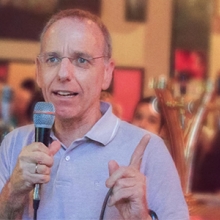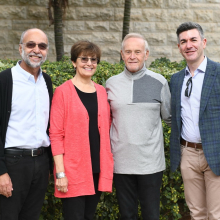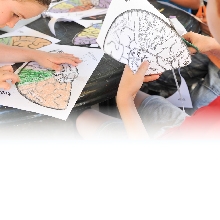Adi Goldenzweig
Heating up the fight against malaria
Students

Malaria is a hot topic, particularly in warm regions like Sub-Saharan Africa where the parasitic disease—which kills an estimated half-million people annually, most of them children—runs rampant. Tropical climate has also stymied efforts to create an anti-malaria vaccine, because parasite proteins, which might be used to “prime” the immune system to combat infection, become unstable at high temperatures.
Now, an algorithm developed by Adi Goldenzweig, a PhD student in the Department of Biomolecular Sciences, has made it possible to redesign proteins to increase their level of thermal stability, without affecting their original function. This advance, described in a publication co-authored by Goldenzweig and her advisor Dr. Sarel Fleishman, could, in the future, lead to an inexpensive malaria vaccine that can be stored at room temperature.
Goldenzweig applied her algorithm to a protein called RH5, which is used by the malaria parasite to anchor itself to the red blood cells it then infects. The essential action mediated by RH5 makes it an ideal agent for triggering an efficient immune response that would prevent continuation of the infection process. Goldenzweig’s work on RH5 was reported recently in Proceedings of the National Academy of Sciences.
Improving on computer-based protein design tools developed in Dr. Fleishman’s lab, Goldenzweig devised a new computational strategy and used it to design an RH5 variant with improved thermal stability. The methodology—which integrates all the known information about how the RH5 protein is configured—produced a “blueprint” for an artificial protein capable of withstanding temperatures up to 57 degrees Celsius (122 degrees Fahrenheit). This would be a huge advantage for malaria vaccines destined for use in developing countries, where refrigeration is often unavailable.
Another advantage is cost. The researchers sent their blueprint to a group at Oxford University specializing in malaria proteins. Not only did that group verify the protein’s thermal stability, it also demonstrated that the RH5 variant could be produced in inexpensive bacterial cell cultures, in large quantities. This is a major step forward because RH5, as it occurs in nature, can only be replicated through the use of complex and expensive technologies. Best of all, in animal trials, the protein was shown to provoke a protective immune response against malaria.
Goldenzweig’s approach involves the use of Rosetta, a software suite for protein modeling created in the University of Washington laboratory where Dr. Fleishman did postdoctoral research.
“The software provides information about all of the atoms in a particular protein, including angles and distances,” Goldenzweig says. “On the computer, we can introduce and model the conformational results of specific changes, with the goal of making the protein more stable, while maintaining the overall shape that is the key to protein functionality.”
Improvements to the original software, introduced by Dr. Fleishman, make it possible to “filter” the huge number of possible variations in protein structure in order to produce a smaller number of relevant results. Goldenzweig’s recent advance renders Rosetta even more efficient.
“In my algorithm, I compare structural data with genetic sequence information found in other databases,” she says. “Searching for shared sequences helps identify how protein ‘design’ works in nature. This makes it possible to narrow down our search for an artificial—and workable—protein structure.”
From arts to sciences
Born in Tel Aviv, Goldenzweig spent her formative years as a serious student of the violin and she now performs with an alternative folk band. While she did not aspire to a scientific career when she was younger, service in an IDF intelligence unit helped her overcome what she refers to as her “technophobia”. After her discharge, she studied both biology and chemistry at Tel Aviv University, and then continued to an MSc at the Institute.
“One of the great things about Weizmann is the rotation program, which allows Masters’ students to work in different labs before settling on a research topic,” she says, adding that, without such an opportunity, students might “play it safe” and never branch out in new directions. After completing her Masters’ degree with Dr. Fleishman, she continued on in his lab as a PhD student.
“The method Adi developed succeeded where others have failed,” says Dr. Fleishman. “It is so general and easy to use that it could be applied to emerging infectious diseases like Zika or Ebola. In infectious diseases, quick action can stop an epidemic from spinning out of control, and save lives.”
Dr. Sarel Fleishman is supported by Anne Christopoulos; The Henri Gutwirth Fund for Research, Carolyn Hewitt, the Rothschild Caesarea Foundation, and Sam Switzer. Dr. Fleishman is the incumbent of the Martha S. Sagon Career Development Chair.








